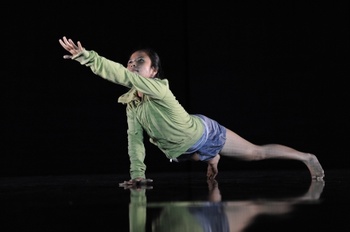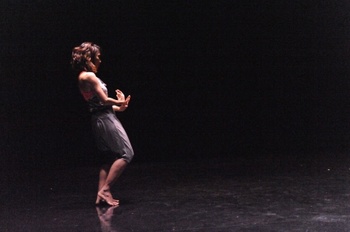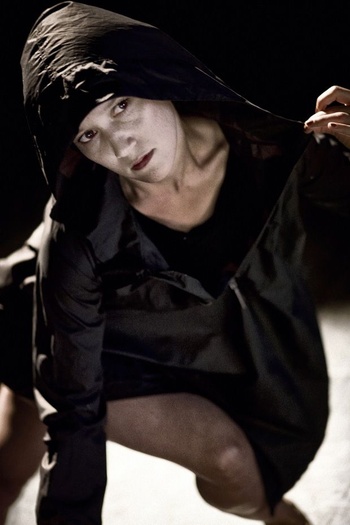Arco Renz about the individual and seduction


A former P.A.R.T.S. dancer, Arco Renz creates his choreographies whilst asking questions. We met him in Brussels to talk about Cambodian dancers in Crack and the business of seduction in Dust.

A German choreographer now living in Brussels, Arco Renz creates choreographies that are minimalist, concentrated, and varied. They often feature dark beauty, black sets, electronic music, and sophisticated lighting. Crack, featuring five Cambodian dancers, will be performed at Bozar, while at Les Brigitinnes, he will be presenting Dust, a piece for five dancers whose erotic movements suggest commercial, rather than romantic seduction. Themes include the individual, freedom, and society.
Why “crack”?
Arco Renz: In English, it might make people think of the drug, but here it’s about the story of Cambodia. “Crack” refers to a country that is “cracking” open under pressure from its young people and looking towards the future. The show is produced by an arts NGO based in Phnom Penh. I selected six dancers trained in Cambodian classical dance, who have little experience of contemporary dance.
So this is a choreography that mixes the traditional with the contemporary?
Renz: Actually, in the show, there is neither Cambodian classical dance nor any fusion of genres. It is a contemporary choreography written on a blank canvas somewhere between both our worlds. I approached their vocabulary, then my own vocabulary, always with the intention that the dancer would appropriate and transform both movement frameworks. I asked the dancers to develop their own individual language.
What is Cambodian classical dance like?
Renz: Like Thai, Indonesian, or Javanese dance, it is very stylised. I haven’t worked with these dances. Instead, I have tried to distil their “physicality”: their slow, fluid motions; the detail of the fingers; the relationship with the ground, etc. In Crack, each dancer liberates himself from their “classical” slowness to discover new physical and interpersonal freedoms. The piece portrays this evolution of individualism in the dancers, which corresponds to the confrontation experienced by young people in Cambodia today. Crack is a meeting with this generation. What does it mean to be “an individual” in a traditional society, where dance is extremely stylised, and where the individual disappears into the form?
Is there Cambodian hip hop and rap?
Renz: Yes, there is a very interesting hip-hop scene in Cambodia, but I am not an expert in this type of dance. The music is a collaboration between Marc Appart, who composes for my choreographies, and young rappers. It was important to integrate hip-hop music. It arrives at the end of the show like the opening of a door to another world…
You also have a production showing in April: Dust
Renz: That is completely different to Crack. Here, the dance explores the mechanism of seduction. With the five dancers, we took courses with several experts in physical seduction, such as pole dancers, striptease artists, and models. This was research, so that we could physically tackle the different universes of seduction. Dust uses the body to depict a kind of seduction that I call commercial seduction. We are all experimenting with this every day, as we are being constantly solicited by desire, consumption, and the hunger to possess things.
Crack 24/3 • 20.30, €18 Paleis voor Schone Kunsten/Palais des Beaux-Arts www.bozar.be
Dust 18, 20 & 21/4 • 20.30, €12 Les Brigittines www.brigittines.be
Why “crack”?
Arco Renz: In English, it might make people think of the drug, but here it’s about the story of Cambodia. “Crack” refers to a country that is “cracking” open under pressure from its young people and looking towards the future. The show is produced by an arts NGO based in Phnom Penh. I selected six dancers trained in Cambodian classical dance, who have little experience of contemporary dance.
So this is a choreography that mixes the traditional with the contemporary?
Renz: Actually, in the show, there is neither Cambodian classical dance nor any fusion of genres. It is a contemporary choreography written on a blank canvas somewhere between both our worlds. I approached their vocabulary, then my own vocabulary, always with the intention that the dancer would appropriate and transform both movement frameworks. I asked the dancers to develop their own individual language.
What is Cambodian classical dance like?
Renz: Like Thai, Indonesian, or Javanese dance, it is very stylised. I haven’t worked with these dances. Instead, I have tried to distil their “physicality”: their slow, fluid motions; the detail of the fingers; the relationship with the ground, etc. In Crack, each dancer liberates himself from their “classical” slowness to discover new physical and interpersonal freedoms. The piece portrays this evolution of individualism in the dancers, which corresponds to the confrontation experienced by young people in Cambodia today. Crack is a meeting with this generation. What does it mean to be “an individual” in a traditional society, where dance is extremely stylised, and where the individual disappears into the form?
Is there Cambodian hip hop and rap?
Renz: Yes, there is a very interesting hip-hop scene in Cambodia, but I am not an expert in this type of dance. The music is a collaboration between Marc Appart, who composes for my choreographies, and young rappers. It was important to integrate hip-hop music. It arrives at the end of the show like the opening of a door to another world…
You also have a production showing in April: Dust
Renz: That is completely different to Crack. Here, the dance explores the mechanism of seduction. With the five dancers, we took courses with several experts in physical seduction, such as pole dancers, striptease artists, and models. This was research, so that we could physically tackle the different universes of seduction. Dust uses the body to depict a kind of seduction that I call commercial seduction. We are all experimenting with this every day, as we are being constantly solicited by desire, consumption, and the hunger to possess things.
Crack 24/3 • 20.30, €18 Paleis voor Schone Kunsten/Palais des Beaux-Arts www.bozar.be
Dust 18, 20 & 21/4 • 20.30, €12 Les Brigittines www.brigittines.be
Read more about: Podium
Fijn dat je wil reageren. Wie reageert, gaat akkoord met onze huisregels. Hoe reageren via Disqus? Een woordje uitleg.